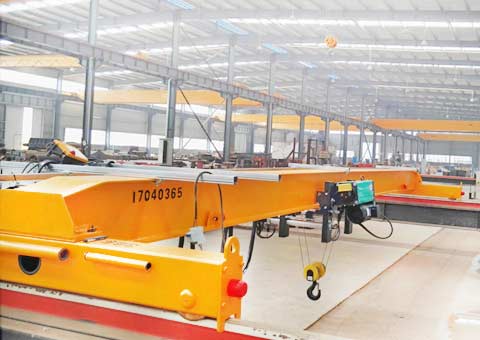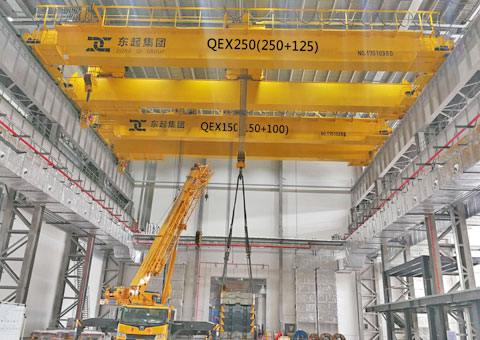Portable Indoor Cranes Types : Gantry vs. Jib vs. Overhead Crane
Types of portable indoor cranes for your selection. An analysis of different types of portable cranes & their respective advantages. Get your crane design now.
Comparing Portable Indoor Cranes: Gantry vs. Jib vs. Overhead
Material handling is a fundamental aspect of many industrial and commercial operations. Efficiently moving heavy loads within a workspace is not only essential for productivity but also for ensuring the safety of workers. In such scenarios, portable indoor cranes emerge as the unsung heroes, providing a versatile and cost-effective solution for a wide range of applications. In this blog, we will embark on a journey through the world of portable indoor cranes and explore the distinct advantages of three primary types: Gantry cranes, Jib cranes, and Overhead cranes. By the end of this comparison, you'll have a clearer understanding of which crane type aligns with your specific material handling needs.
Gantry Cranes
Gantry cranes, sometimes referred to as portal cranes, are versatile material handling machines that are designed to provide mobility, flexibility, and cost-effective solutions in various industrial and commercial settings. They are distinct for their unique design, featuring a horizontal bridge supported by upright legs or columns, which can be mounted on wheels or casters for easy movement. Gantry cranes come in both fixed-height and adjustable configurations, making them adaptable for a range of applications.
Portable indoor crane - mobile gantry cranes 500kg -10 ton
Advantages of Gantry Cranes:
a. Mobility
One of the standout features of gantry cranes is their exceptional mobility. They are designed to be highly mobile, allowing them to be moved around a workspace with ease. This mobility enables you to transport heavy loads to various locations within your facility without the need for extensive infrastructure changes. Whether you have shifting work requirements or need to optimize your floor space, gantry cranes are a practical solution.
b. Cost-Effectiveness
Gantry cranes are often more cost-effective than permanent overhead crane installations. The initial setup costs, as well as ongoing maintenance expenses, tend to be lower, making them an attractive choice for businesses looking for an economical material handling solution. Additionally, the ease of assembly and disassembly means they can be used when needed and stored when not in use, further contributing to cost savings.
c. Lifting Capacity
Gantry cranes are available in various weight capacities, ensuring suitability for a wide range of loads. Whether you need to lift lightweight or exceptionally heavy items, there is likely a gantry crane configuration that matches your specific requirements. This versatility in lifting capacity makes gantry cranes a practical choice for a multitude of industries and applications.
In summary, gantry cranes offer a flexible, cost-effective, and adaptable solution for material handling within industrial and commercial environments. Their mobility, budget-friendly nature, and diverse lifting capabilities make them a reliable choice for businesses with varying material handling needs. Whether you require a crane that can be easily repositioned, want to keep costs down, or need to lift a wide range of loads, gantry cranes should be high on your list of considerations.
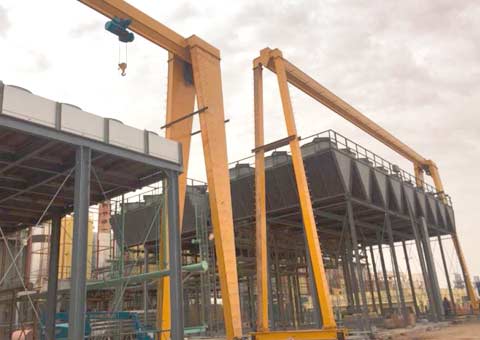 Rail travellig mobile gantry crane with single girder design
Rail travellig mobile gantry crane with single girder design 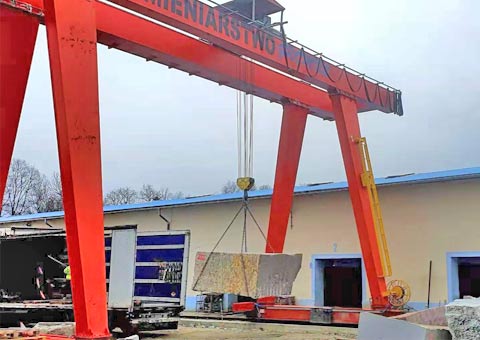 Rail travellig mobile gantry crane with double girder design
Rail travellig mobile gantry crane with double girder design Jib Cranes
Jib cranes are a distinct type of portable indoor crane designed for localized lifting and precise material positioning. Their fundamental design consists of a horizontal boom or jib, which is typically mounted to a pillar, wall, or an existing structure within the workspace. Jib cranes are known for their efficiency in situations where precise load handling and positioning are critical.
Portable jib crane 0.25kg -2 ton for sale, cost-effective solution
Advantages of Jib Cranes:
a. Precise Positioning
Jib cranes excel at precise positioning of loads. The fixed or pivoting jib arm allows for accurate control over the placement of items, making them ideal for tasks that demand a high degree of accuracy. This characteristic is particularly valuable in assembly lines, workstations, and scenarios where goods or components need to be precisely positioned or maneuvered.
b. Space-Efficiency
Jib cranes are inherently space-efficient. They do not require the extensive floor space needed for gantry or overhead cranes. Their vertical or horizontal installation on walls or pillars optimizes the use of workspace, which can be crucial for businesses operating in smaller or more crowded areas.
c. Cost-Effectiveness
Jib cranes are often a cost-effective solution for material handling tasks that do not require high lifting capacities or extensive reach. Their relatively simple design and easy installation contribute to their affordability. For businesses seeking economical solutions without compromising on precision, jib cranes provide an ideal balance.
In summary, jib cranes are exceptional tools for situations that demand precise load positioning, efficient use of space, and a cost-effective approach to material handling. Their capacity for accurate positioning, space-saving installation, and budget-friendly nature make them a valuable asset for businesses in a variety of industries. Whether you need to streamline assembly processes, optimize limited floor space, or manage materials cost-effectively, jib cranes are an attractive choice.
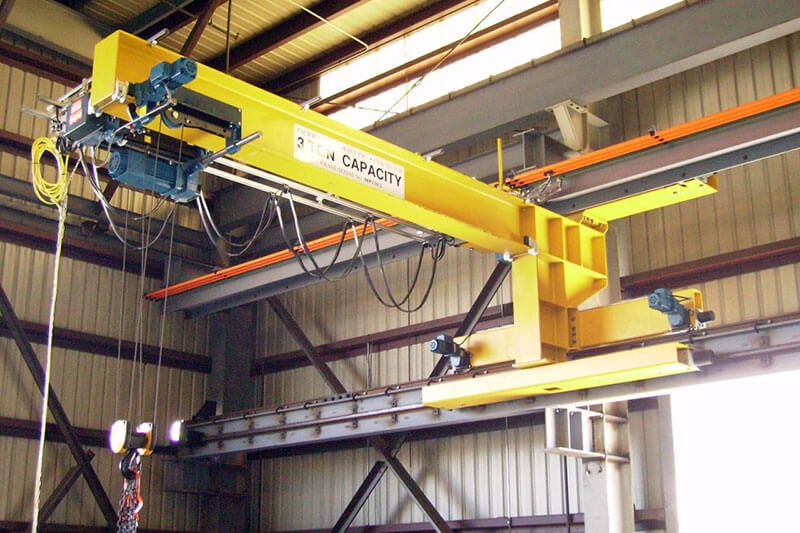 Mobile jib crane travelling on the rails
Mobile jib crane travelling on the rails 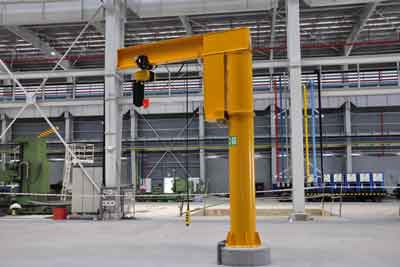 Floor mounted jib crane with 360 degree rotationg
Floor mounted jib crane with 360 degree rotationg Overhead Cranes
Overhead cranes, also commonly referred to as bridge cranes, represent the heavyweight champions of the portable indoor crane world. They are an indispensable material handling solution in large facilities, known for their robust design and ability to handle substantial loads. The primary configuration of an overhead crane consists of a horizontal bridge that travels along elevated rails, with a hoist or hook for lifting and lowering loads. They are typically suspended from the ceiling structure of the facility
Advantages of Overhead Cranes:
a. High Lifting Capacity
One of the most significant advantages of overhead cranes is their exceptional lifting capacity. These cranes are built to handle extremely heavy loads, making them the preferred choice for industries that require heavy-duty material handling. From manufacturing and construction to steel production, overhead cranes are trusted to manage large, weighty items with ease.
b. Full Coverage
Overhead cranes provide full coverage of the workspace. Their bridge structure allows them to move loads smoothly across the entire floor, without the constraints of floor-mounted cranes. This feature is invaluable in large facilities, warehouses, or industrial environments where extensive material handling is a daily necessity.
c. Durability
Overhead cranes are designed to withstand long-term, heavy-duty use. They are built with durability in mind, ensuring a reliable and robust material handling solution that can endure the test of time. This resilience is especially critical in demanding industries where operational uptime is paramount.
In summary, overhead cranes are unmatched in terms of their high lifting capacity, ability to cover the entire workspace, and their durability. These features make them the go-to choice for industries that deal with massive and unwieldy loads. Whether you need to transport raw materials, assemble heavy machinery, or manage materials in large storage facilities, overhead cranes are a reliable and durable solution for your material handling needs.
Choosing the Right Crane
Selecting the appropriate crane type is a critical decision, and it's essential to consider a few key factors to ensure it aligns with your specific facility requirements. Here are some considerations for making the right choice:
- a. Load Weight and Size -First and foremost, assess the weight and size of the loads you'll be handling. Different crane types have different lifting capacities, and choosing one with the appropriate capacity is crucial to ensure safety and efficiency. Whether you're dealing with light loads, heavy machinery, or everything in between, matching the crane's capacity to your typical load is paramount.
- b. Available Space -Evaluate the available workspace within your facility. Consider the layout, height of the ceiling, and any obstructions that may affect crane movement. Gantry cranes and jib cranes are often more space-efficient, while overhead cranes require ample vertical space.
- c. Mobility and Flexibility -Assess whether you need a crane that can be easily moved to different locations. Gantry cranes are highly mobile, while jib cranes and overhead cranes have more fixed positions. Mobility is particularly important if you have shifting work requirements or if you want to maximize space usage.
- d. Precision and Load Positioning -If your operations demand precise load positioning, jib cranes might be the ideal choice due to their ability to offer accurate control. If your work involves repetitive tasks that require consistency and precision, this should be a top priority in your decision-making process.
- e. Budget Considerations -Consider your budget constraints. Gantry and jib cranes are often more cost-effective solutions, especially when compared to the expenses associated with the installation and maintenance of overhead cranes. Determine the initial setup costs and ongoing maintenance expenses that fit within your financial framework.
- f. Industry and Application -Different industries have varying material handling needs. If you work in a specialized field, such as manufacturing, construction, or heavy industry, the demands for your crane solution may be unique. Ensure that the crane type you choose aligns with the specific requirements of your industry.
- g. Expert Guidance -Collaborating with trusted suppliers or manufacturers is invaluable. Their expertise can provide you with insights into which crane type is most suitable for your particular needs. They can offer guidance on crane installation, maintenance, and even customization if required.
In conclusion, selecting the right crane for your facility is not a one-size-fits-all decision. It should be tailored to your unique operational requirements. Taking into account load weight, available space, mobility, precision, budget, industry-specific needs, and seeking expert guidance will help you make an informed choice. The appropriate crane will not only enhance the efficiency of your material handling but also contribute to the overall safety and productivity of your operations.
Conclusion
In our journey through the world of portable indoor cranes, we've explored three main types: Gantry cranes, Jib cranes, and Overhead cranes. Each of these crane types offers a unique set of advantages that cater to various material handling needs. Let's recap the key takeaways and emphasize the importance of making an informed choice for your facility.
Advantages of Gantry Cranes:
- Mobility:Gantry cranes are highly mobile, allowing for easy relocation within the workspace.
- Cost-Effectiveness:They are often a more budget-friendly option compared to permanent installations.
- Lifting Capacity:Gantry cranes come in various weight capacities, making them versatile for a wide range of loads.
Advantages of Jib Cranes:
- Precise Positioning:Jib cranes offer exceptional control and accuracy for load positioning.
- Space-Efficiency:They make the most of limited space with their vertical or horizontal installations.
- Cost-Effectiveness:Jib cranes are cost-effective for tasks not requiring high lifting capacities.
Advantages of Overhead Cranes:
- High Lifting Capacity:Overhead cranes excel in lifting extremely heavy loads.
- Full Coverage:They provide full workspace coverage, ideal for large facilities.
- Durability:Overhead cranes are built to last and withstand heavy-duty use.
Choosing the right crane is a critical decision, and it should be based on your facility's specific requirements. Here's why it matters:
Your choice of crane will impact not only your efficiency but also the safety of your workforce. Selecting a crane with the right lifting capacity ensures that your operations are not only efficient but also secure. If you prioritize precise load positioning or have limited workspace, choosing a crane that aligns with these needs can significantly enhance your workflow. Moreover, staying within budget is always a crucial consideration to ensure your material handling solutions are cost-effective.
Collaborating with trusted suppliers or manufacturers who specialize in cranes is a valuable step. Their expertise can help you navigate the nuances of each crane type, ensuring that your choice is well-informed and tailored to your facility's unique requirements. They can also provide guidance on installation, maintenance, and customization if necessary, ultimately enhancing the performance and longevity of your crane.
In conclusion, the world of portable indoor cranes is diverse, offering solutions for a wide range of applications. Whether you need mobility, precision, high lifting capacity, or cost-effectiveness, there's a crane type that's just right for you. Making an informed choice ensures that your material handling processes are not only efficient but also safe and reliable. So, don't hesitate to work with experts and invest in the crane that best suits your needs—it's an investment that will pay off in increased productivity and peace of mind.


